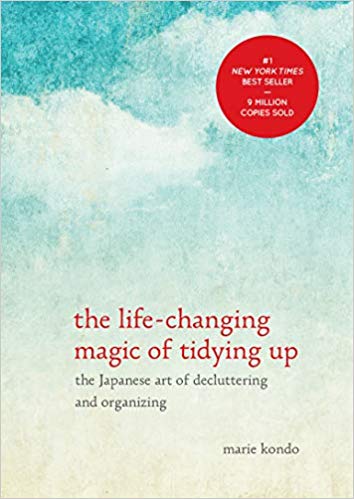

This article is an excerpt from the Shortform summary of "The Life-Changing Magic of Tidying Up" by Marie Kondo. Shortform has the world's best summaries of books you should be reading.
Like this article? Sign up for a free trial here .
Have too much stuff, and not sure how best to get rid of it? Marie Kondo is a world-renowned expert on tidying, and this book teaches you how to get past the most common barriers preventing you from decluttering. Go through the Konmari method once, and you may find your relationship with things to be changed permanently.
Marie Kondo’s Tidying Categories, at a High Level
The basic process is to discard first, then organize what’s left.
The KonMari process helps you avoid typical stopping points that afflict most people decluttering. Don’t do it little by little, do your whole house in one go (as much as you can depending on your schedule–it’s fine if it takes up to 6 months). And go by category, not by room.
For each of Marie Kondo’s categories, gather all the items together in a giant pile, discard first, then organize what’s left.
Here’s the correct order of Konmari categories that makes things mentally easier:
- Clothes
- Books
- Papers
- Komono (miscellany)
- Sentimental items
For each category, go through every single item like so:
- Pick it up.
- Ask yourself, does this item spark joy?
- If it does, keep it.
- If it doesn’t, thank it for everything it’s done for you. Then move it to the discard/donate pile.
After you’ve discarded items in a certain category, then you can move on to organizing what’s left in that category.
Why does Marie Kondo go by Categories?
This is a fatal mistake most people make while tidying: going by room instead of by category.
Most of us have similar items in different locations, like coats in a coat closet in the hall and clothes in a dresser in the bedroom. If we tidy by room, we end up doing the same kind of work over and over–this can lead to burnout.
Tidying by category lets us do one kind of work in totality, no matter where the objects are in your space. Plus, most of us have no idea how much stuff we own, so tidying by category is the wake up call we need.
- For example, for clothing, you’ll put every single item of clothing you own on your bed. You’re going to be floored by the volume of clothes you have, and you’d never realize that if you tidied by room.
The correct sequence of categories: clothes, books, papers, komono/miscellany, mementos. In each category, gather all the items together at once, discard first, then organize what’s left.
Going in the correct sequence speeds up the process and makes it easier in 3 ways:
- It allows you to go from easier categories to harder categories, not only psychologically but in terms of storage as well.
- It helps you refine your ability to choose what to keep as you go along.
- It helps build good habits before you get to communal areas and shared objects or sentimental stuff that can be difficult to discard.
Do not start with mementos. Don’t even think about sentimental items until everything else has been sorted. If you discover one as you go through other categories, put it aside immediately.
- They cloud our judgement and are the hardest things to make decisions about.
- Because they’re rare and can’t be replaced, we resist throwing them away.
- This is also usually a big category, and will take too much energy out of us before we’ve streamlined our discarding system.
Now let’s go through each of Kondo’s five categories in order:
Konmari Category #1: Clothing
If you have a lot of clothes or want a more organized approach, break it down into subcategories: tops, bottoms, hanging clothes, socks, undergarments, bags, accessories, event-specific clothing like swimsuits, and shoes.
There are 2 major categories of clothes people have difficulty dealing with: 1) clothes they bought but never wore, and 2) clothes they hope to fit into one day.
- For clothes you bought but never wore: thank them for teaching you that you don’t like to wear that style of clothing, and discard them.
- For clothes you hope to fit into one day: clothes that you can’t wear right now are useless to you unless you’re on the verge of being able to wear them and actively working toward that goal. Thank them for motivating you to get in better shape, discard them, and buy clothes that fit you in your current size and spark joy.
Folding and storing vertically is better than hanging in terms of storage. The goal for folding is to make the smallest, smoothest, simplest rectangle that can stand up on its own. (Shortform note: There are much more detailed instructions in Chapter 5.)
Some clothes need to be hung, like suits and dresses, and these should be grouped by category.
Konmari Category #2: Books
Take all your books off their shelves and out of any piles they’re already in. If you have a lot of books, you can break them down into these subcategories: general books you read for pleasure, practical books you use for reference, visual books like photography or art books, and magazines.
Don’t read any books as you sort through them to discard. This will cloud your judgement.
Many people have difficulty in this category, specifically with books they still intend to read, and books they think they’ll reread again…
———End of Preview———

Like what you just read? Read the rest of the world's best summary of Marie Kondo's "The Life-Changing Magic of Tidying Up" at Shortform . Learn the book's critical concepts in 20 minutes or less .
Here's what you'll find in our full Marie Kondo summary :
- The psychological benefits of tidying
- How to Tidy the Konmari method
- How to deal with Clothing, Books, Papers, and Sentimental Items
- ...and much more







Thank you for this post! I did my clothing… it took me 6 hours to do those. It also inspired my parents to go through his. Feels great to have only stuff that fits and have some empty space.
That’s so amazing. I’m learning how to become a minimalist. Thanks for sharing!
I have organized over and over. I stopped buying for over a year. I went from a large home to a 2 br apartment. I had a garage storage I rented. I went through that and donated and fold things and it took me 5 years. Im really ready to do Maries way. I need to buy more shelf bins and plastic shoeboxes for under the sink, etc. I need to stay organized and be more aggressive daily. I need motivation guys! Thanks.
Quickly and easy!